| dc.contributor.author | Maithya, Jacob | |
| dc.contributor.author | Charo, Harrison | |
| dc.contributor.author | Okeyo-Owuor, JB | |
| dc.contributor.author | Wangila, BCC | |
| dc.contributor.author | Ouma, Henry | |
| dc.contributor.author | Orinda, Charles | |
| dc.contributor.author | Hoggren, Mats | |
| dc.contributor.author | Dannewitz, Johan | |
| dc.contributor.author | Carlsson, Martin | |
| dc.date.accessioned | 2015-11-10T07:58:58Z | |
| dc.date.available | 2015-11-10T07:58:58Z | |
| dc.date.issued | 2006 | |
| dc.identifier.citation | Aquaculture Strategy For Restoration of Threatened Lake Victoria Fishes: The case for Oreochromis variabilis (Boulenger, 1906) and Labeo victorianus (Boulenger, 1901) Jacob Maithya1, Harrison Charo1, J. B. Okeyo-Owuor2, B.C.C. Wangila3, Henry Ouma1, Charles Orinda1, Mats Hoggren4, Johan Dannewitz5 and Martin Carlsson5 | en_US |
| dc.identifier.uri | http://repository.eac.int/123456789/729 | |
| dc.description.abstract | The endemic Oreochromis variabilis and L. victorianus are among Lake Victoria’s most threatened fish
species whose population sizes are on the decline. This study, carried out between August 2000 and April
2001, aimed at characterizing the ‘refugia’ ecosystems of O. variabilis and its growth performance in small
water bodies (SWBs), developing artificial spawning techniques and characterizing existing morphological
and genetic variation of extant populations of L. victorianus in order to bring the species under aquaculture
as a restoration strategy. Studies of O. variabilis were carried out by comparing its growth performance in
stocked semi-intensive and modified extensive closed systems in different ecological zones within the Lake
Victoria basin. Growth in O. variabilis evaluated as average growth rates, was satisfactory in both systems
and eco-zones, even in areas with extreme environmental gradients. The isometric characteristics of
O.variabilis estimated by formula W = aLb were better than those of wild populations in the ‘refugia’
ecosystems in each respective eco-zone. Multivariate analysis of morphological data showed that there was
reasonable differentiation between L. victorianus populations from different drainages, with the southern
populations being most distinct. Majority of the variation in L. victorianus was within populations (91.3%),
with an overall FST of 0.08846 for all loci. For effective aquaculture and conservation, fish breeders should
use local fish material for their stocking programs; yet ensure that different age classes form part of their
brood-stock. L. victorianus was spawned artificially using intramuscular injection of Clarias gariepinus
pituitary extracts (C.g.PE) and Human chorionic gonadotropin (HcG) to induce ovulation. Successful
inducement of ovulation occurred only in trials with C.gPE. Fertilization rates in breeding experiments for
L. victorianus averaged 86% and hatching percentages 70%. This study indicates the viability of the two
species for culture in the basin. More hope is therefore raised for expansion on the farming practices in the
basin. Such a fisheries production can provide 75% of the animal protein requirements of the poor rural
households and guarantee continued survival of the species within the basin. Stocking of small water bodies
for increased fish production enhances further, the integrated resource use and management of the endemic
but threatened Lake Victoria fish stocks. | en_US |
| dc.language.iso | en | en_US |
| dc.publisher | KMFRI Sangoro Aquaculture Research Station, P.O. Box 136, PAP-ONDITI, Kenya, 2 School of Environmental Studies, Moi University, P.O Box 3900, ELDORET, Kenya | en_US |
| dc.subject | Oreochromis variabilis | en_US |
| dc.subject | Labeo victorianus | en_US |
| dc.subject | Genetic variation | en_US |
| dc.subject | Restoration | en_US |
| dc.subject | Ecology | en_US |
| dc.subject | Small water bodies | en_US |
| dc.title | Aquaculture Strategy For Restoration of Threatened Lake Victoria Fishes: The case for Oreochromis variabilis (Boulenger, 1906) and Labeo victorianus (Boulenger, 1901) | en_US |
| dc.type | Article | en_US |

